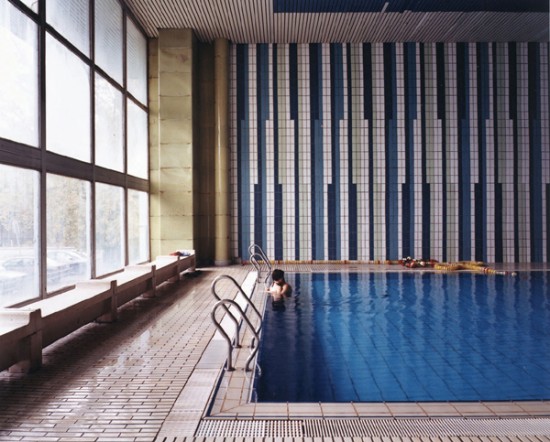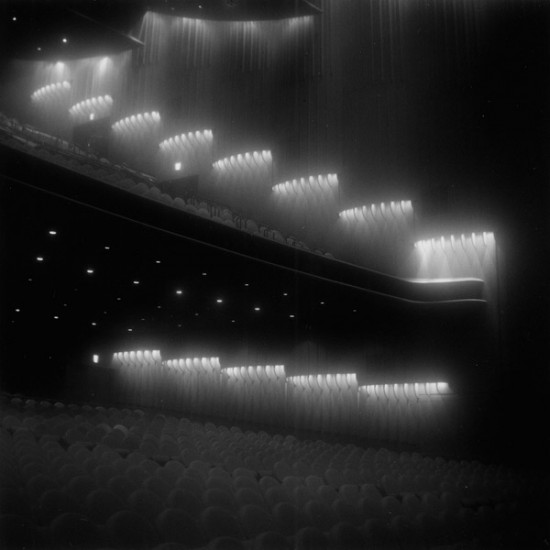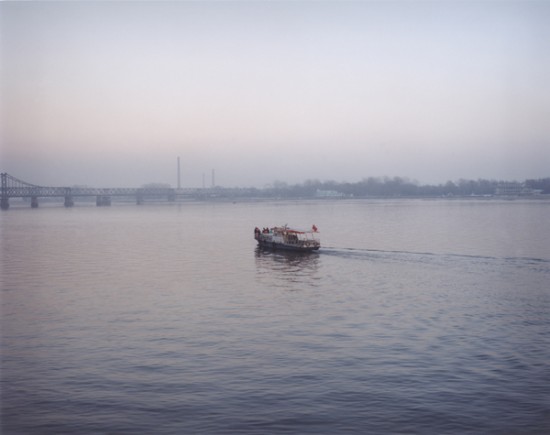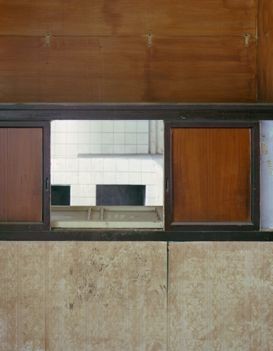II. Frames of Consciousness
Tomoko Yoneda on the photography of paradigm shifts.
 Lovers, Dunaujvaros (formerly Stalin City), Hungary (2004), C-type print, 66 x 84 cm. All images: © Tomoko Yoneda, courtesy ShugoArts, Tokyo.
Lovers, Dunaujvaros (formerly Stalin City), Hungary (2004), C-type print, 66 x 84 cm. All images: © Tomoko Yoneda, courtesy ShugoArts, Tokyo.ART iT: We were just discussing how you draw from diverse research and visual references in producing even a single image, while at the same time exploiting the relations between text and image to transform a single image into multiple images. Did this kind of methodology develop intuitively, or from a consideration of photo theory?
TY: It was an intuitive process, not something that I arrived at through theory. Maybe it results from having been conscious about my identity as a Japanese person living abroad. In Japan, you might have little awareness of the Japanese mentality and one’s own social context and background. However, once you go abroad you necessarily enter an environment where you cannot help but be aware of your identity, and through that experience you also become aware of many other different backgrounds, mentalities and historical perspectives. I think that has influenced my works.
ART iT: Obviously there are physical limitations if you’re living overseas, but was it a conscientious decision on your part not to deal with Japan in your early works?
TY: It was partly so. I studied in the US before going to England. There is already a difference between the visibility of history in the US and in Europe, which I was extremely conscious of in my work after moving to Europe. I arrived there in 1989, right as the Berlin Wall was coming down and the Soviet Union was collapsing. Prior to that the world had been entrenched in the Cold War – everything was in a continuous stalemate. To then witness it all collapsing felt like witnessing a paradigm shift. Being in Europe at that moment changed the way I see things. I understood that things we had believed in because they were there right in front of us would not necessarily last forever, and indeed had the potential to collapse or become something else entirely. I probably wouldn’t have realized this had I been in Japan at the time. However, I think Japan is experiencing a similar paradigm shift after March 11, 2011, and it feels fateful that I am now back here under such circumstances.

 Top: TAKARAZUKA THEATER, TOKYO (Clausen & Vutokevich) (2008), gelatin silver print, 9.5 x 9.5 cm. Bottom: Wedding – View of the wedding party on the river that divides North Korea and China, Dandong, China (2007), C-type print, 76 x 96 cm.
Top: TAKARAZUKA THEATER, TOKYO (Clausen & Vutokevich) (2008), gelatin silver print, 9.5 x 9.5 cm. Bottom: Wedding – View of the wedding party on the river that divides North Korea and China, Dandong, China (2007), C-type print, 76 x 96 cm.ART iT: The paradigm shift certainly seems to be a mechanism that you conceptually reenact through your works. In terms of the concrete process of making the photographs, though, what considerations go into the formats that you use for each project, from size to color to effect? For example with the series about the Sorge spy ring, “The Parallel Lives of Others” (2008), it seems you chose to use a pinhole camera.
TY: For “Parallel Lives” I wasn’t using a pinhole camera, I was using a Kodak Brownie. I imagined that when a spy meets another spy for the first time, there must be a mutual distrust or sense of confusion among them. Even though there is documentation of the actual words they exchanged, and the places where they met, there’s always some ambiguity as to whether those events actually took place or not, or what actually happened. As spies, even if they had families and everyday lives, they probably could not share their experiences with those families. So I wanted to show through the photographs how everything is fuzzy with regard to spies. I was going for a phantasmal effect, something slightly out of focus. In fact, there are actual photographs that the spies took of each other, and almost all of these photos are blurry. So I chose the format and approach that I thought best reflected the understanding I arrived at after synthesizing all my research, including the photos I had seen and the documents on the spies I had studied at libraries and archives.
But “Parallel Lives” was a unique case. Generally I like to take crisp, large-format photographs. The first time I used medium format was when I went to Hungary and Estonia for my project “After the Thaw” (2000-04). Many times on location during that project, people would enter the frame or there were things moving across the landscapes. For example, there is the photograph, Lovers, Dunaujvaros (formerly Stalin City), Hungary (2004), with the two lovers in the pool. Having done research on the background of the city, I wanted to make a photo of the pool with its Socialist Realist design motifs, but then the lovers entered the frame. Thinking about movement, it was at that moment that I switched from large format to medium, and then took the shot. Since that time I have always worked with large and medium formats in tandem. Another example is the shoot that resulted in Wedding – View of the wedding party on the river that divides North Korea and China, Dandong, China (2007). I initially wanted to photograph the bridge at Dandong, which had been bombed by the Americans during the Korean War and collapsed into the river. The bridge had been built by the Japanese so they could cross back and forth from Korea into Manchukuo and China. In this case, too, where I had planned to shoot using a large format camera, the wedding boat suddenly entered the frame and I hastily switched to a medium-format camera. When I was shooting, beyond thinking about relations between Japan and North Korea, I also thought that if China could act as a go-between, then there might be some improvement to the current fierce standoff, so the wedding party was symbolic in that sense, but also simply because I found the idea of the potential trajectory of the wedding itself to be interesting.
ART iT: The post-war architecture in Eastern Europe reflects a unique design heritage that is attractive to contemporary sensibilities. Is there any difference photographing in a location with such highly-charged aesthetics, as opposed to, say, the border between China and North Korea or the rather nondescript “banzai cliff” in Saipan?
TY: I was a child when Expo ’70 was held in Osaka, and feel there must be some kind of connection between the utopian vision that was expressed there and the architecture of Eastern Europe. My personal opinion is that architecture and design that are visibly inspired by ideology can be stronger than anything else.
When photographing architecture, I begin by assessing elements like form and color. I fundamentally have a preference for precise, formalistic photographs, and have no patience for photos that are distorted – “Parallel Lives” being the anomaly, in that I was playing around with an unusual approach.
I would say this is the influence of having studied photography at the University of Illinois at Chicago, where one of my teachers had studied with the New Bauhaus school at Illinois Institute of Technology. And of course in Chicago there are many buildings by Mies van der Rohe and Walter Gropius – I was particularly attracted to those designed by Mies. Although if someone were to draw parallels between my work and that of so-called Chicago School photographers like Aaron Siskind and Harry Callahan, I would disagree.


Left: Former house of General Wang Shu-ming, the Chief of Staff under Chiang Kai-Shek, Cidong Street, III (2010), C-type print, 83 x 65 cm. Right: Former house of General Wang Shu-ming, the Chief of Staff under Chiang Kai-Shek, Cidong Street, V (2010), C-type print, 83 x 65 cm.
ART iT: So when you look at works other than your own, and particularly when you look at photographs, do you tend to respond to them visually, or more through context?
TY: I prefer photographs with context. There are of course photographs I like based on their technical elements, but really when I’m looking at works I like to think about context. For example, I like Bill Brandt’s photographs, which touch upon social issues. Although I don’t like Lee Miller so much, I do like the photographs she took while on assignment covering the battlefields of Europe during World War II. And in terms of combining context and formalism, I think Margaret Bourke-White’s photographs are truly excellent.
Tomoko Yoneda: The Multiple Lives of Images
